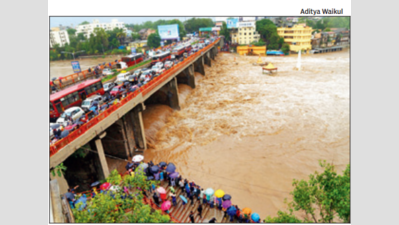- News
- City News
- nashik News
- Nashik gets heaviest 24-hr July rain in a decade, Godavari touches danger mark
Trending
This story is from July 11, 2016
Nashik gets heaviest 24-hr July rain in a decade, Godavari touches danger mark
Incessant rain in the past 48 hours surpassed the average July rainfall in Nashik within ten days.It was also the highest recorded rainfall within 24 hours for the month of July in a decade.

People watch the rising Godavari in Nashik.
Key Highlights
- Nashik city received 184.4mm rain between July 9 and July 10 (up to 5.30pm), the highest in 24 hours according to the IMD.
- The water level in the Godavari on Sunday rose quickly. Four vehicles were washed away in the flood water.
Nashik: Incessant rain in the past 48 hours surpassed the average July rainfall in Nashik within ten days. It was also the highest recorded rainfall within 24 hours for the month of July in a decade.
The Godavari river, which runs through the city, was in spate after eight years with the water touching the danger mark, the blue floodline, by 4.30pm on Sunday.
Nashik city received 184.4mm rain between July 9 and July 10 (up to 5.30pm), the highest in 24 hours according to the Indian Meteorological Department (IMD). From 8.30am to 5.30pm on Sunday, the city received 133.3 mm rain. IMD data said 130mm rain was recorded in 24 hours on July 2, 2007, while 80.1mm was recorded on July 30, 2014.
The water level in the Godavari on Sunday rose quickly. Four vehicles were washed away in the flood water, while the fire brigade personnel rescued two persons trapped in the flood water. A source said this was the first time that the river had risen without release of water from Gangapur dam. The Nashik Municipal Corporation has warned residents in the low-lying areas of the river to shift to safer zones.
Waterlogging on the road prevented motorists from gauging the depth of the potholes.
The Godavari river, which runs through the city, was in spate after eight years with the water touching the danger mark, the blue floodline, by 4.30pm on Sunday.
Nashik city received 184.4mm rain between July 9 and July 10 (up to 5.30pm), the highest in 24 hours according to the Indian Meteorological Department (IMD). From 8.30am to 5.30pm on Sunday, the city received 133.3 mm rain. IMD data said 130mm rain was recorded in 24 hours on July 2, 2007, while 80.1mm was recorded on July 30, 2014.
The water level in the Godavari on Sunday rose quickly. Four vehicles were washed away in the flood water, while the fire brigade personnel rescued two persons trapped in the flood water. A source said this was the first time that the river had risen without release of water from Gangapur dam. The Nashik Municipal Corporation has warned residents in the low-lying areas of the river to shift to safer zones.
Meanwhile, vehicles waited in serpentine queues on the waterlogged Mumbai-Agra and Nashik-Pune highways, after the heavy rainfall. Highway police officials, Nashik division said potholes in the ghat section had caused the slow-down of vehicular movement.
Waterlogging on the road prevented motorists from gauging the depth of the potholes.
End of Article
FOLLOW US ON SOCIAL MEDIA










